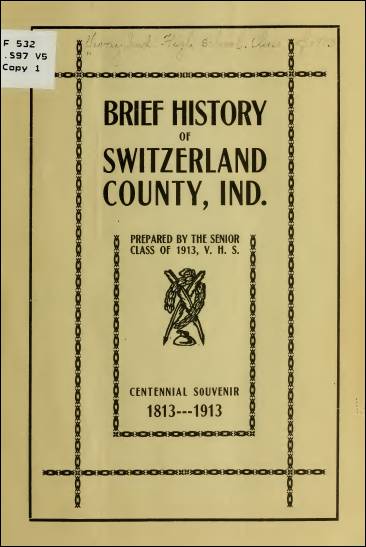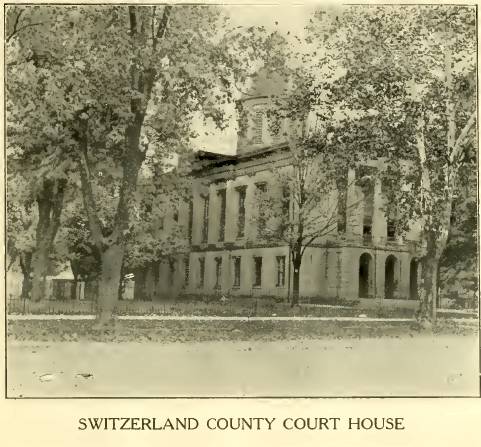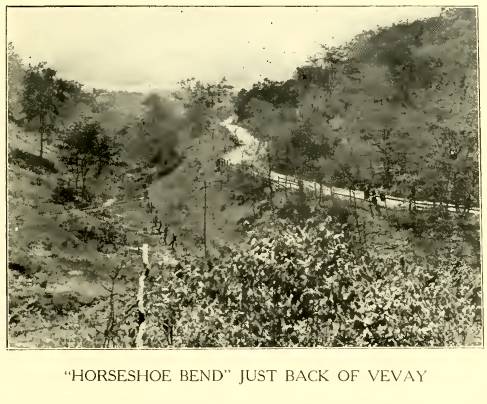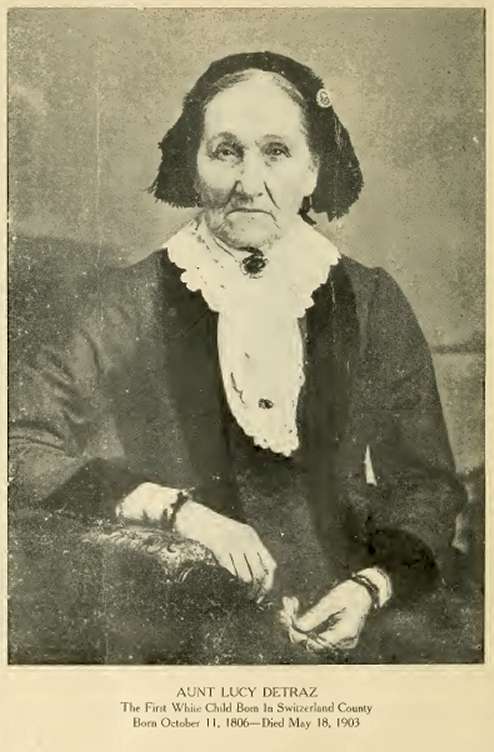

 |
 |
|
| H ISTORY INDEX | HOME PAGE MENU / SEARCH |
BRIEF HISTORY of SWITZERLAND COUNTY, IND.Prepared by the Senior Class of
1913, V. H. S.
Centennial Souvenir 1813---1913 Source: Internet Archive, https://archive.org/details/briefhistoryofsw00veva  PREFACE
This little pamphlet is the outgrowth of an effort to study briefly our own local history in connection with the regular History and Civics work of the High School. The suggestion was made that a committee be appointed by the senior class of 1913 from among its membership to gather material relating to the history of Switzerland County and report to the class. As the plans for the celebration of our one hundredth anniversary matured, the purpose of the pupils in arranging this brief history broadened somewhat. The committee conceived the idea that while they were being helped by the effort involved they might produce a work that would be a fitting souvenir for the Centennial Celebration to be held during the week of August 18--24, 1913. No doubt many errors and imperfections will be found in this little book -- imperfections in language, probably inaccurate statements and overlapping of material. It is hoped and believed, however, that the reader will look beyond these faults, whatever they may be, and see the zeal, the sincerity and pleasure of the boys and girls in preparing this work. The following committee gathered and arranged all of the material: Harold Curry, Elizabeth Porter, Perle Johnson, Eugene Scudder and Elmer Brown. They were greatly aided by many of the high school pupils and especially by the children from the sixth, seventh and eighth grades. An effort has been made throughout the pages to indicate the source of the data, by marginal references. Acknowledgment should be made here to The History of Switzerland, Dearborn And Ohio Counties, to Miss Julia L. Knox for an article written by her a few years ago and appearing in the "Indianian," to the local newspapers and to the "History of Indiana and Its People" by Robert J. and Max Aley, and to Mrs. S. O'N. Pleasants. All of these have been helpful to the pupils. RALPH
X. TIREY, Supt. of Schools,
CHAPTER
I.
In the latter part of the eighteenth century when the extent
of the vast North
American territory began to be realized by our forefathers, growth in
the East was checked for
a time while men with their families made a mad rush for the West.Geographical Factors. Had it not been for the perseverance of our sturdy ancestors they might never have reached this side of the Allegheny Mountains, but they were dauntless and after many hardships were able to reach Pittsburg whence the way was practically easy down rivers on boats or rafts, according to their financial condition, and across the intervening land in large canvas covered wagons drawn by horses or oxen. After the settlement of Cincinnati, immigration moved southward reaching Lawrenceburg in 1795. A year later the first settlers set foot on Switzerland county soil. The fertile river valley, guarded from winds and storms by the majestic hills, attracted Heathcoat Pickett to make a home near Vevay where he was soon joined by other progressive colonists. (Notes of Perret
Dufour)
As the
rainfall was not regular,
our forefathers were obliged to resort to their "water wands" which
consisted of a forked peach
limb that inclined toward the ground where water was supposed to be
found.(History of Three
Counties)
Early settlers were also influenced to make their homes in
this part
of the country on account of the heavy timber which covered the land
out of which they built substantial homes and stockades against the
Indians
and wild beasts which at first proved hostile to the white men. Among
the
latter mentioned were deer, bear and wolves which in savage fierceness
howled over the
carcass of their latest victims -- the fox, panther and racoon [sic].
The
ground hog's shrill whistle
might also be heard in these woods while wild turkeys and native song
birds added to the natural
atmosphere of Switzerland county.They also were anxious to settle where they could ship their products out easily and the Ohio river afforded this possibility. Heathcoat Pickett's first flatboat was the beginning of river traffic in this section. ----------
CHAPTER II. Early Settlers and Settlements (History of Indiana)
History is nothing more
nor less than a record of past events and that of Indiana began July 4,
1800, but many settlements were made however as early as the first half
of
the eighteenth century, the first one being at Ouiatanon, on the Wabash
river about 1720. Many
more settlements were made and finally some were made in Switzerland
county.(History of
Three Counties)
A colony of Swiss settlers crossed the Allegheny
Mountains, and coming down the
river made settlements along the banks of the Ohio. They made their
first settlement at
Lawrenceburg but were not content to settle permanently until they
reached the beautiful hills of
"New Switzerland!" Gradually they pushed their way down the river and
made some settlements in
Switzerland county.(Material brought
by Paul Coleman)
The first one in
this county of which any
record can be found was made by Heathcoat Pickett in the year 1795; he
erected a cabin about
three miles  
from Vevay near Plum Creek, and lived there many years. (Paul Coleman and
Mabel
Brindley)
The family consisted of the father, mother, two sons and one
daughter. They endured
many privations and often narrowly escaped the tomahawks or scalping
knives of the Indians.
The country was very wild at that time and there were wild animals as
well as wild Indians.Mr. Pickett made the first flatboat on which he made twenty trips to New Orleans, and as he was a good pedestrian he walked back after selling his boat each time. (Dorothy
Campbell)
In 1798 the
Cotton and Dickason families came to this section of the country and
settled on Indian Creek, a
few miles back of the Ohio river.(Merriam Protsman)
William Cotton
lived in a large
sycamore tree until his cabin was built. He took an active part in the
politics of
Indiana and was the first Justice of the Peace. He received his
appointment from General Harrison, then Governor of the territory.In 1814 he was made Associate Judge and in 1816 was a delegate to the Constitutional Convention which famed the constitution of Indiana. He was a member of the first Senate after this state was admitted to the Union. (Irene
Babcock)
John Rayl, another
settler, came here in 1798. He settled at the foot of the Vevay Island.In 1799 Robert Gullion settled in the Ohio river bottom along the mouth of Log Lick creek. (Harold Curry)
In the following year an act of congress affected the
settlement of Vevay. This act stated that anyone who would settle in
the Ohio
Valley and spend his time cultivating grapes would be given the tract
of land between which is now
Plum and Indian Creek. The Swiss took advantage of this opportunity and
began the
cultivation of grapes. In their own country the grapes thrived better
on the
hillside, so they decided to make the little valley in which Vevay is
now situated look like their own home town of Vevey, Switzerland, by
clearing
the hills and leaving the valuable timber of stately poplar, beech and
walnut.This group of Swiss settlers came from the Canton Dewaird in Old Switzerland where Vevay is the chief city. Among the families were the Mennets, Bettens and Morerods. Soon the Schencks and Thiebauds came, and later the Gaudins. (Mabel Brindley)
Another family
among these was
that of John James Dufour. They had located in the big bend of the
Kentucky river, a place
chosen by Mr. Dufour in the spring of 1796 when he first came to this
country.(Lillian Gleason)
In
1802 they made preparations for a settlement in this country by
clearing the land. In 1813 the
first house was put up by Samuel Butler and his family.In the same spring Joshua Jones floated a set of house logs from Grants Creek and built a house on the lots now owned by James Bristow (Anonymous)
In 1816 the Detraz family came to Vevay. Only a short time
after his arrival
Mr. Detraz was drowned while bathing in the river. His body was found
at Madison and interred there.About this time Frederick L. Grisard Sr. came with his brother-in-law
and settled below Indian Creek. He was a blacksmith for several years. When his son-in-law who was a shoemaker, moved to Louisville, Mr. Grisard came to Vevay. (Lillian Gleason)
In
1817 John James
Phillip Schenck with his wife and son, Ulysses P., came here and
settled on a farm on the hill
back of Vevay, the Thiebaud farm. Mr. Schenck was a tinner by trade and
as there were no tinners in
Vevay he did all the mending of tinware and also making of new
utensils. He came to town once
or twice a week and got together all of the tinware to be mended.His son commenced business at Louisville and stayed there until 1837. (Dorothy Campbell)
In 1817,
what is known as the
Dutch settlement was made in Pleasant township. A few years later they
supplied Vevay with
butter, eggs and chickens during the summer, and pork, venison, oats,
wheat and flax in winter. They
organized a church soon after they came and built a log meeting house.Some Scotch people settled back of what is now Moorefield, among whom were the Dows, Taits and Allens. (Mabel
Brindley)
In 1817, 1818 and 1820 several families settled on Long Run.
Among them were Neil
McCallum, John McCallum, Donald Cowan and the Malcomsons. These
people were Sevenday
Baptists and always held Saturday as their sacred day.(Court House)
Lamb was settled by an
Irishman whose name was Macintyre. He called the place Erin.Florence was called Little York, after New York, which was a thriving city at this time. It was surveyed by Benjamin Drake in the year 1816. The population at this time was less than seventy. Some of the most prominent citizens were William Cambell, John Drake, John Gibson, Geo. Hutchins and Martin Adkins. (Court House)
Patriot was named after "Troy." This town, Florence,
Center Square and Vevay
contended for the honors of being the county seat. Center Square was
originally intended for the
county seat, but finally it was settled by a vote of the people and
Vevay came
out victorious.----------
CHAPTER III. Pioneer Life. In discussing the life of the early settlers of Switzerland county, one must remember the proverb "that there must be pioneers" in everything. Some one has to overcome the obstacles that the following generations may enjoy the life laid out for them by their forefathers. Going back to the earliest time in our local history, we find that the pioneers came from the eastern and southern states. These large, hardy, industrious settlers whose manner and speech were so unpolished but whose hearts were so warm, did not realize what foundation they were laying for the future Switzerland county. After landing and selecting a place for his home, the pioneer had to live the best he could until the house was built. Among the early settlers who experienced such hardships was William Cotton, who crossed the river from Kentucky in 1798 and while erecting his log cabin, lived in a sycamore tree on Indian Creek. A few of the old log cabins that were built at the settling of the county are still standing. These were
|